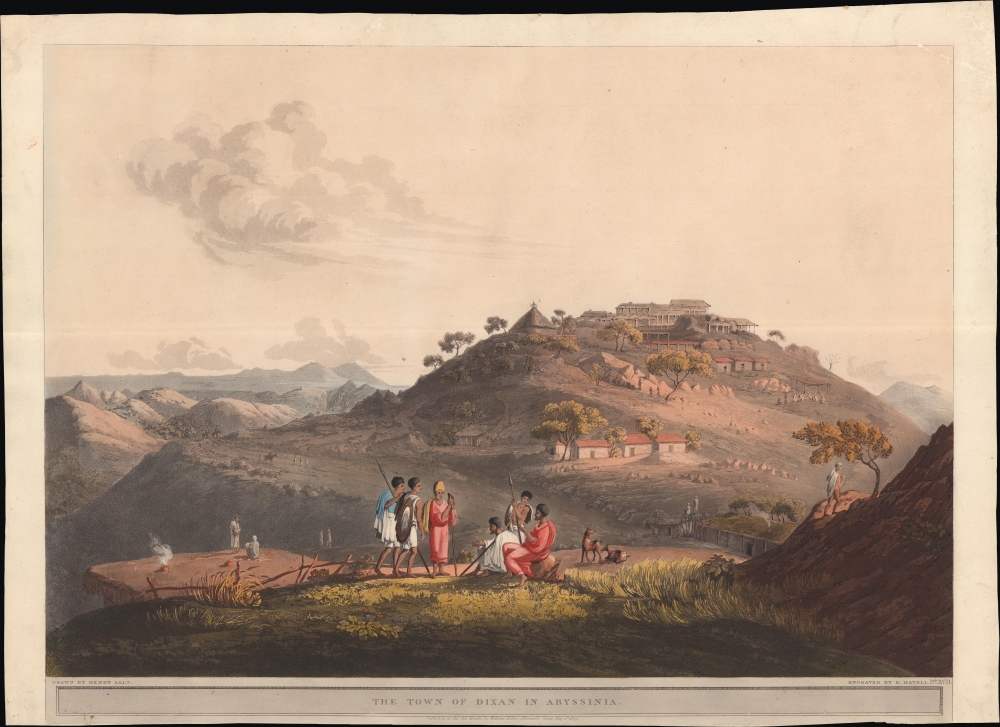Digital Image: 1809 Salt / Havell View of Dixan, Abyssinia (Ethiopia)
DixanAbyssinia-salt-1809_d
Title
1809 (dated) 17.5 x 23.5 in (44.45 x 59.69 cm)
Description
FOR THE ORIGINAL ANTIQUE MAP, WITH HISTORICAL ANALYSIS, CLICK HERE.
Digital Map Information
Geographicus maintains an archive of high-resolution rare map scans. We scan our maps at 300 DPI or higher, with newer images being 600 DPI, (either TIFF or JPEG, depending on when the scan was done) which is most cases in suitable for enlargement and printing.
Delivery
Once you purchase our digital scan service, you will receive a download link via email - usually within seconds. Digital orders are delivered as ZIP files, an industry standard file compression protocol that any computer should be able to unpack. Some of our files are very large, and can take some time to download. Most files are saved into your computer's 'Downloads' folder. All delivery is electronic. No physical product is shipped.
Credit and Scope of Use
You can use your digial image any way you want! Our digital images are unrestricted by copyright and can be used, modified, and published freely. The textual description that accompanies the original antique map is not included in the sale of digital images and remains protected by copyright. That said, we put significant care and effort into scanning and editing these maps, and we’d appreciate a credit when possible. Should you wish to credit us, please use the following credit line:
Courtesy of Geographicus Rare Antique Maps (https://www.geographicus.com).
How Large Can I Print?
In general, at 300 DPI, you should at least be able to double the size of the actual image, more so with our 600 DPI images. So, if the original was 10 x 12 inches, you can print at 20 x 24 inches, without quality loss. If your display requirements can accommodate some loss in image quality, you can make it even larger. That being said, no quality of scan will allow you to blow up at 10 x 12 inch map to wall size without significant quality loss. For more information, it is best consult a printer or reprographics specialist.
Refunds
If the high resolution image you ordered is unavailable, we will fully refund your purchase. Otherwise, digital images scans are a service, not a tangible product, and cannot be returned or refunded once the download link is used.
Cartographer S
Henry Salt (June 14, 1780 - October 30, 1827) was a British artist, traveler, diplomat, and Egyptologist active in the first decades of the 19th century. Salt was trained as an artist and traveled extensively in Asia as secretary and draughtsman to George Annesley, the Veiscount Valentia. His first expedition, which lasted from about 1802 to 1806 involved travels to Cape Colony, the east coast of Africa, the Ethiopian Highlands, and India. His paintings from the expedition were published in Annelsey's 1809 Voyages and Travels to India. Afterwards Salt returned to Africa on a government sponsored mission to Ethiopia in the hopes of establishing diplomatic and trade relationships with the Tigrayan warlord Ras Wolde-Sillasie. Salt published the narrative of this expedition in his 1814 book A Voyage to Abyssinia, which also featured a collection of important maps. Today Salt is best known as an Egyptologist and collector of antiquities. In 1815 he was appointed British Consul-General in Cairo, where he dedicated himself to building a vast collection of Egyptian antiquities. Around this time, the ancient monuments and tombs of Egypt were a free-for-all for enterprising Europeans with a penchant for antiquities. Salt and other European adventurers, among them Italian Bernardino Drovetti, had hard reputations and were willing to stop at nothing to obtain choice pieces. Among Salt's top acquisitions are the head of Ramses II and the sarcophagus of Ramses III, located at the British Museum and the Louvre, respectively. Salt built three massive collections, each containing thousands of artifacts. Most of these pieces were acquired by the British Museum, where they rest to this day, though some did find their were to other institutions, such as the Louvre, and into various private collections. More by this mapmaker...
Daniel Havell (c. 1785 - 1822) was a British engraver and a member of the multigenerational Havell family of engravers, etchers, painters, and publishers. The details of Daniel's life and his place in the family's lineage have been disputed, in part because of the frequent use of certain names in the family, but in any event he appears to have trained in the family business in the late 18th and early 19th century. Daniel is listed as the engraver on most of the plates in Henry Salt's Twenty-Four Views in St. Helena, the Cape, India, Ceylon, Abyssinia and Egypt. Around 1815, he appears to have struck out on his own and produced views of sites around London and Cambridge instead of the exotic sites depicted in his earlier works. Details on his life and death are scant, but a 1826 book on the history of the theaters of London notes its plates as being engraved by 'the late Daniel Havell.' Learn More...
William Richard Beckford Miller (March 25, 1769 - October 25, 1844) was a prominent British publisher of the late 18th and early 19th century. He was born in Suffolk, the son of Thomas Miller, a well-known bookseller and antiquarian. He briefly studied art at the Royal Academy before shifting to training in the publishing industry under Thomas Hookham in London. In 1790, he started his own shop, specializing in large (quatro), richly-illustrated and colored volumes. As a result, in the first decade or so of the 19th century, the works he issued were especially popular. In 1812, Miller sold his business and its assets to competitor John Murray. Following his early retirement, Miller briefly tried his hand at farming and country life before returning to London, where he remained a respected figure in the publishing and bookselling world despite no longer being engaged in business. Learn More...

